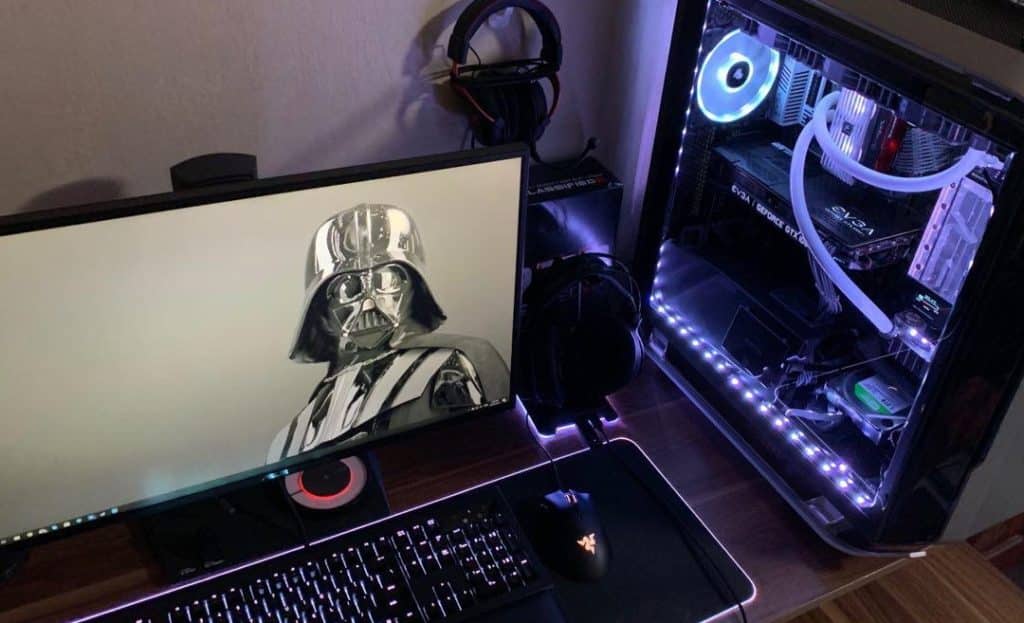The Gigabyte GS32Q is one of the best cheap gaming monitors you can buy, and it has balanced specifications that will upgrade your visual experience. It has a larger 32-inch screen with a 170Hz refresh rate, making it a steal at its price point, which usually only affords a 1080p variant. Let’s look closer to whether it’s a worthy upgrade for your gaming setup.
Gigabyte GS32Q Specifications
- Screen Size: 32 Inches
- Resolution: 2560 x 1440 WQHD
- Aspect Ratio: 16:9
- Panel Technology: In-Plane Switching (Fast IPS)
- Refresh Rate: 170Hz
- Response Time: 1ms
- Contrast Ratio: 1200:1
- Brightness: 300 cd/m²
- Built-in Speakers: None
- Stand: Height – No
- Stand: Tilt – Yes
- Stand: Swivel – No
- Stand: Pivot – No
- VESA Compatibility: Yes 100 x 100
- Connectivity: DisplayPort 1.4 x 1, HDMI 2.0 x 2, 3.5mm x 1
- Dimensions With Stand(WxHxD): 28.11″ x 19.72″ x 9.37″
- Weight: 15.87 lbs
Design and Features
The Gigabyte GS32Q looks like a regular monitor, but it is noticeably sleeker than most alternatives in the same price range. The monitor has a matte black finish, so it doesn’t stand out too much and distracts you from what’s happening on the screen. The display has a bezel-free design, but it still has inner borders like any regular monitor.
It’s larger than your typical monitor, but it doesn’t consume as much space as the curved variants. It only needs 9.37 inches of depth, but it still is quite imposing since it’s a few steps larger than your typical display at work or in the office. The whole thing only weighs 15.87 pounds, but extra care is still necessary since it’s quite big.
Gigabyte monitors are known to be cheaper, but they managed to make this model even more affordable. However, they did not sacrifice its overall build quality just to lower the price beyond the norm. The weakness here is the stand, which gives way to some wobbling due to the low center of gravity, but that’s expected.
The Gigabyte GS32Q has a joystick for the OSD and compatibility with Gigabyte’s OSD Sidekick app. It is very convenient to adjust the settings on the fly, especially if you want to use main features like Game Assist or Black Equalizer. Other budget models have to make do with buttons, which are a minor inconvenience, but they can be annoying to use in the long run.
The included stand only offers tilt, so it’s a bit limiting compared to what the M32Q has. It also sits quite low on the chassis, so it can allow the large chassis to wobble at times. You can use VESA mounts to make it more flexible, but that’s an additional cost that might break the money-saving premise of the monitor.
The Gigabyte GS32Q’s connectivity layout was also simplified to help with the cost cutting. It only has DisplayPort 1.4 and two HDMI 2.0 slots, along with a 3.5mm jack for convenience. The more expensive M32Q has USB-C, but its added flexibility adds more cost.
You also don’t get speakers with this model, but that’s fine since gaming displays are better enjoyed with headsets or gaming speakers. Built-ins are useful in some instances, but not a lot out there are powerful and detailed enough for playing or watching movies. We’d rather get a cheaper price than have 2-watt sets that sound silly when turned all the way up.
Display and Performance
The Gigabyte GS32Q sports a 32-inch IPS panel with a 2560 x 1440 resolution, a 170Hz refresh rate, and a 1ms MPRT response time. The backlight has a 300 cd/m2 output, while the contrast is listed at 1200:1. This model doesn’t have HDR certification, but Gigabyte did mention that it’s HDR-ready, indicating that it can accept HDR signals.
32-inch 1440p monitors are not as sharp as the more popular 27-inch models and are more or less comparable with a 24-inch 1080p variant. However, that doesn’t mean that games will look less crisp or detailed since they still have a higher pixel count. That also means that you will need a more powerful GPU, but 1440p gaming doesn’t need a flagship card nowadays.
The Gigabyte GS32Q covered 100% of sRGB and 89% of DCI-P3 for great color performance in games and movies. Its default accuracy had a deltaE average of 1.87, so it looks balanced out of the box. Most users won’t need to do any calibration before using it, so it’s a great choice for beginners and experts alike.
Calibrating it reduced the dE average to 0.78, making it usable for editing work and content creation. However, you will need a colorimeter to achieve that, and those are more expensive than the monitor itself. We recommend prioritizing a better monitor before getting the gadget if color accuracy is essential to you.
The Gigabyte GS32Q’s backlight reached 303 cd/m2 at 100%, so it can fight off a decent amount of glare. Its contrast peaked at 1146:1 at 40% brightness, making it a bit better in present dark scenes and color gradients than most IPS monitors. However, it’s not the same as a VA or OLED panel, so take that advantage with a grain of salt.
Panel uniformity for the test sample had some issues due to backlight leaks on the upper edge of the display. They showed up mostly in dark scenes but are less noticeable against white backgrounds. Note that this can vary with every monitor made due to tolerances, so there are better and worse units out there.
The Gigabyte GS32Q’s response time is way better than what the G32QC can offer since it has a Fast IPS panel versus the latter’s curved VA. You don’t need a lot of overdrive to make it usable for fast-paced games, but keeping your framerates above 120 FPS is a must. Dropping the output to 60Hz is a different case since it effectively lowers the pixel response time of the monitor.
The Gigabyte GS32Q is compatible with FreeSync and G-Sync for smooth and stutter-free gaming. Dual compatibility is a must-have now since both GPU companies have very competitive options for 1440p gaming. Its input lag sits at 4ms at 170Hz, so it is suitable for any fast-paced game.
Thoughts on the Gigabyte GS32Q
The Gigabyte GS32Q is a brilliant choice for budget gamers who want to upgrade their visual experience. It’s fast and responsive, plus it’s vibrant and decently accurate out of the box. It is not the most equipped option in Gigabyte’s lineup, but it has the essential features to make your setup more enjoyable.
The Gigabyte GS32Q is far from perfect since it has a few handicaps that help lower the price. The M32Q is a much better option, and it doesn’t cost a whole lot to get one compared to this monitor and a VESA mount. However, it’s a fantastic budget option if you want to upgrade while spending as little as possible.
Pros:
- Great Colors and Contrast
- Fast and Responsive
- Very Affordable
Cons:
- Tilt Stand
- Limited Features
About the Author: 





Leave a Reply